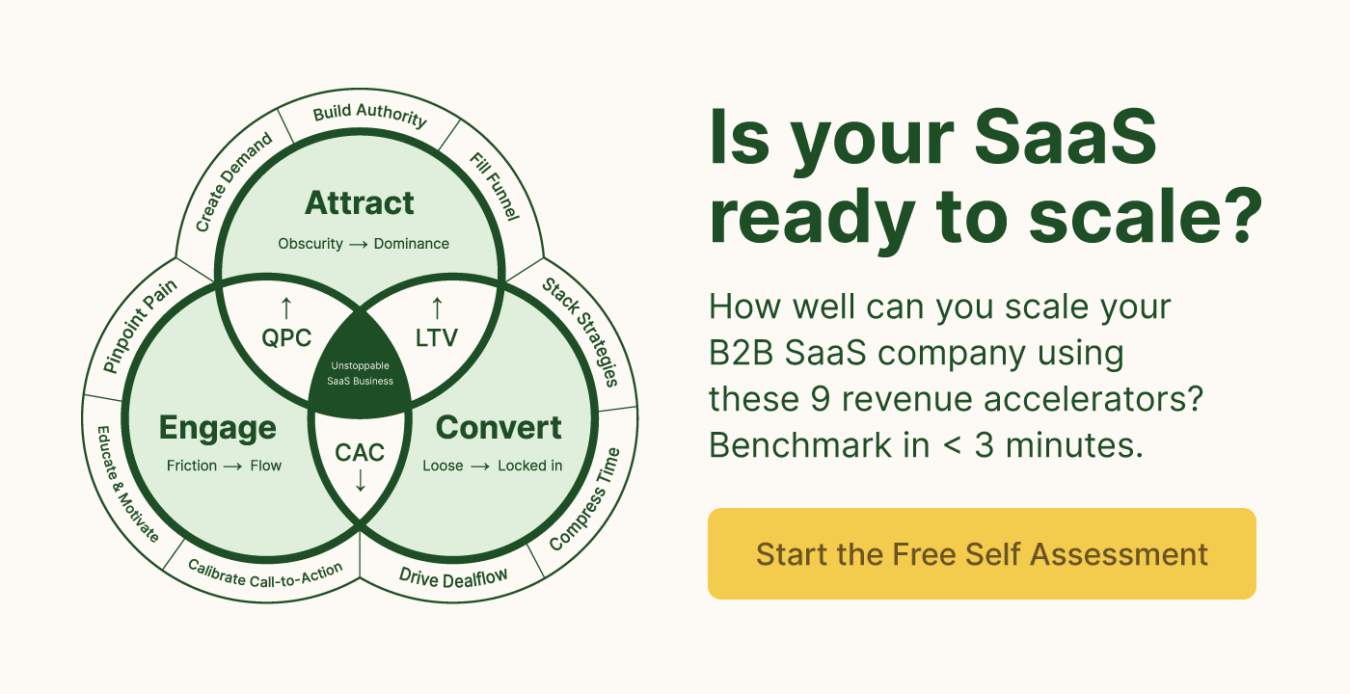B2B SaaS Link Building Strategies That Actually Work In 2024
Last updated: May 27th, 2024
There’s overwhelming evidence that links can help your content rank higher, which will ultimately make your overall strategy much more effective.
The only problem is that many SaaS companies we talk to that have previously invested in link building found that it was largely ineffective.
As a result, many SaaS marketers quit link building altogether.
The only problem is that without links, your content likely won’t rank, and as a result, you’ll waste a lot of money creating content that nobody will ever read.
So how do you predictably build links that help your content rank in search engines?
In this post, we’ll explain the B2B SaaS link building mistakes most companies make that cause their efforts to fail and the exact strategies we use to consistently help clients achieve results like these:
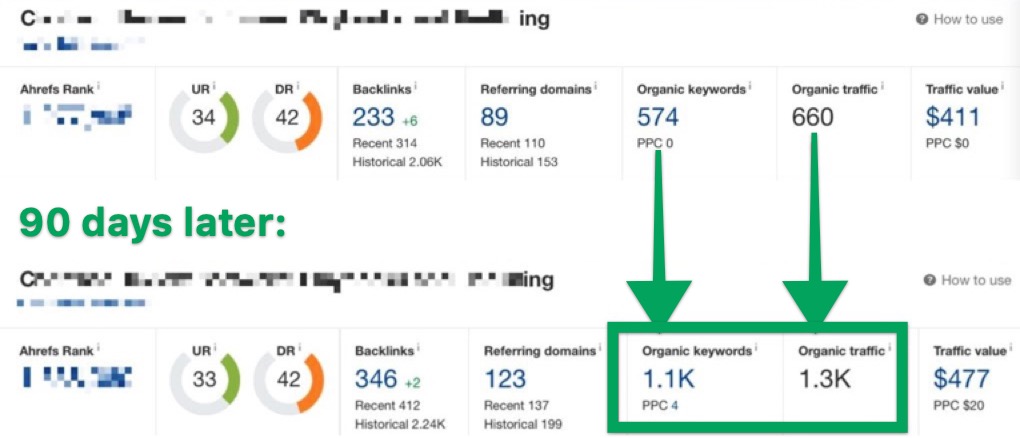
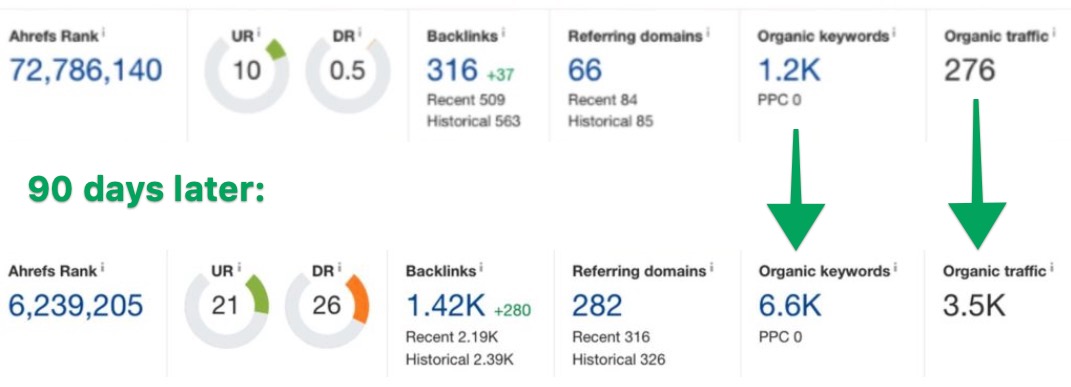
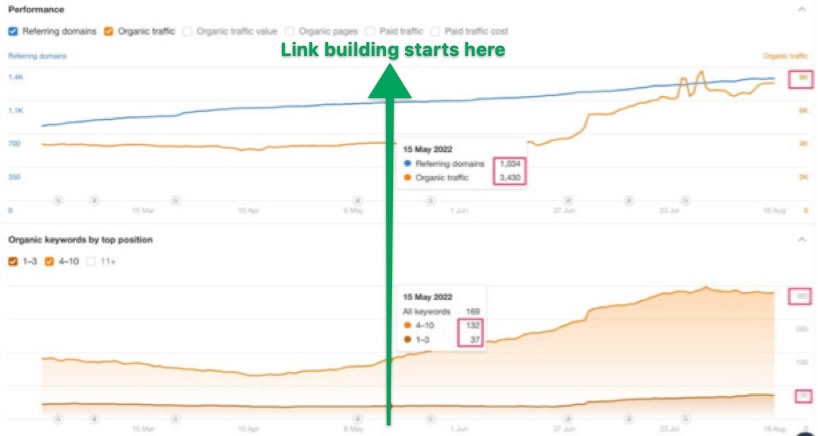
Note: Link building and content promotion is a part of our SEO services for B2B SaaS companies. Schedule a Free Marketing Plan to learn more about how we can drive leads for your business through SEO.
Common SaaS Link Building Mistakes
The typical process SaaS companies use for link building includes reaching out to link building vendors, asking for an arbitrary number of backlinks from websites with a domain rating of 50 plus.
Six months into this approach, most SaaS companies are disappointed with their results and scrap link building altogether.
So before you start building links, here are the three most common SaaS link building problems we frequently see marketers make that cause the strategy to fail.
Mistake #1: Building The Wrong Links
Not all links are equally valuable. You might already know that links from websites with high domain authority are better than those with low domain authority, but that isn’t the only factor that determines the quality of a link.
We have a detailed criteria to evaluate the quality of a potential link opportunity, though some of the main factors you need to consider when evaluating the quality of a link opportunity include:
- The page authority: Many marketers only look at the domain authority, but the page authority (how many links/traffic that particular page has) is also important. This is why we don’t do guest posting, as earning a link from a brand new page provides minimal benefit as it has a page authority of zero when you first start.
- Topical relevance: Search engines view links as a vote of credibility from one website to another. Therefore, if the links you’re earning are from websites that are irrelevant to your niche (e.g., earning a link from a nutrition blog when you’re selling a cybersecurity SaaS product), it won’t help your website be seen as an authority in your industry (cybersecurity).
- Type of link: We ideally like to earn followed links that are placed contextually in the article with relevant anchor text. No follow links or links that are placed in a large directory of links are less effective.
Mistake #2: Building Links To The Wrong Pages
Many link building vendors build links to either the website’s homepage or random pieces of content.
However, the page receiving the link receives the most direct benefit from the link. Therefore, linking to random pages is often a wasted opportunity.
Instead, we strategically select specific pages to build links to.
While we have a specific criteria for selecting the best pages to build links to, the two major factors we look at include:
- The value of the page: We prioritize sending links to “money pages” or pages that drive a lot of conversions. This might be bottom of the funnel blog posts or product pages.
- Competition: We look at the top ranking pages for the target keyword and analyze the “link gap” (how many more links and the quality of those links) between the top ranking page and our page. This helps us identify low hanging fruit and pages that will be much more difficult to boost in the SERPs.
Mistake #3: Lack a Proven System
Sending thousands of emails and asking website masters to link to you probably won’t help you earn any links.
Instead, you need to identify how linking to your website is beneficial for the website you’re pitching. Unfortunately, looking at each individual website and crafting a personalized message that explains why it’s beneficial for them to link to your website isn’t a very scalable link building strategy.
Therefore, you need sophisticated systems and processes to scale a personalized link building strategy.
While scaling link building isn’t impossible, it’s certainly the most challenging aspect of the process. In this post, we’ll highlight the main link building strategies we currently use with our SaaS clients that still work today.
14 Strategies for Building Backlinks to Your SaaS Website
Here are the main SaaS link building strategies that we find are still effective today.
For each strategy, we’ve indicated both impact and ease as being either low, moderate, or high to help you prioritize which actions make the most sense for your business.
1. Resource Link Building
Many content writers link to helpful resources on similar topics that they mention in passing within their main article, so you can earn links by creating and promoting these resources.
Historically, the best approach to earn links with the resource building tactic was to use the Skyscraper Technique to create the most thorough resource on a topic. However, this tactic has been used so often that it’s not particularly effective anymore.
Therefore, to create resources that are truly linkable, we consider two factors; uniqueness and usefulness.
Unique Content: If you want to create unique content, the types of content we have found work best are thought leadership pieces, opinion pieces, and mission or value-driven content. Here are two examples of unique content:
- The Scammers of the Blogging World — a piece by ConvertKit founder Nathan Barry that calls out “get-rich quick” schemers — is an example of thought leadership pieces. Articles like this stir emotion inside of us, and both people who agree and disagree are compelled to share and link to it.
- In Problems with Email, “Hey” by Basecamp lays out a simple list of 25 problems with email (that almost anyone could nod their head along to) that led them to creating their new email product. This piece not only makes a statement by calling out what’s wrong with email, but its relatability and relevance to just about anyone makes it inherently sharable and linkable.
Useful Content: We established that simply creating a longer, more thorough resource is no longer an effective strategy to create the “ultimate” resource on a topic. Instead, we make resources uniquely useful by providing information that is helpful and currently doesn’t exist anywhere on the internet. For example, we’ll create original surveys and studies that answer important industry questions that would help your target audience be more successful.
2. Broken Link Building
If a website is incorrectly linking to a piece of content that no longer exists or is outdated and you have a replacement piece that is relevant and higher quality, you can reach out to the site owner to notify them of the dead link and offer your content as a solution.
Often, this can include competitor content that was moved or abandoned.
Broken link building is mutually beneficial because it helps the other website keep their content up to date.
This link building method is fairly easy to execute as you can use a tool like Ahrefs to identify all of the broken links on a large, relevant website in one sitting:
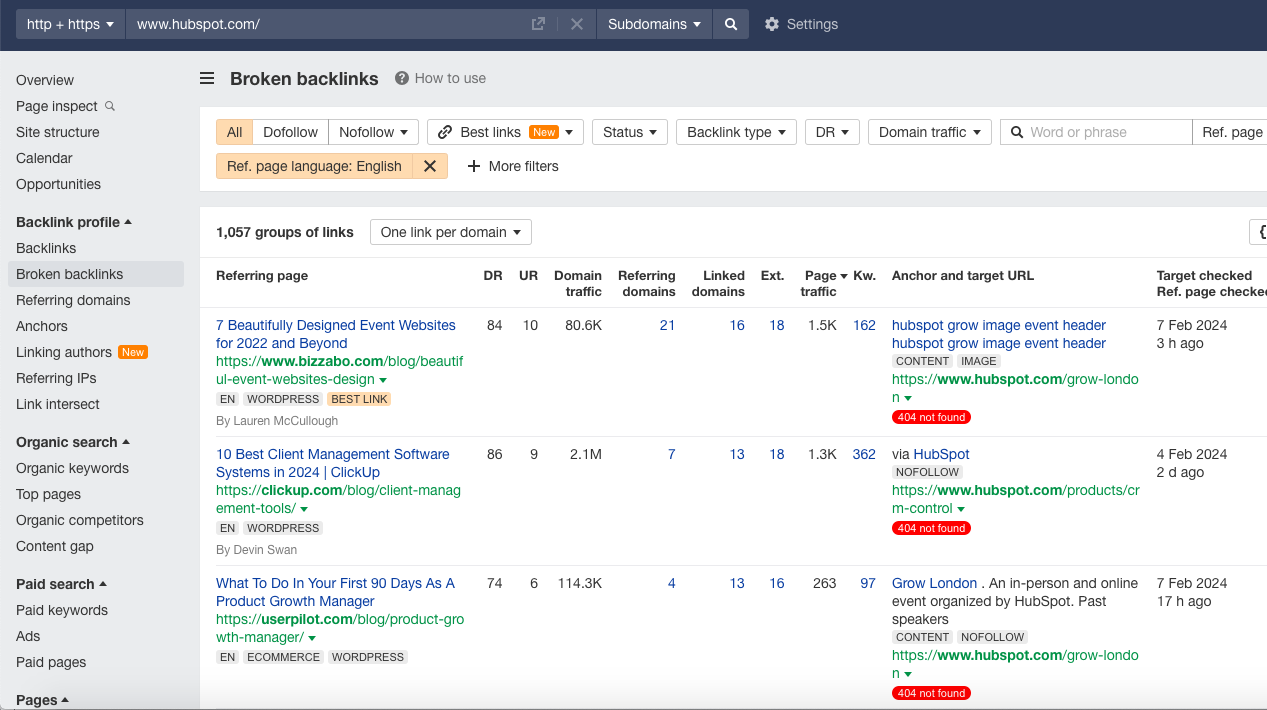
3. SaaS Directories and Review Sites
Listing your product on many of the numerous SaaS directories and review websites adds backlink equity and social exposure to your brand. Many of these popular websites receive large volumes of traffic as customers explore their options for products, so it can be a great place for initial discovery.
Here are a few examples:
- Capterra
- G2 Crowd
- GetApp
- SaaS Genius
- TrustRadius
- Finances Online
- Crozdesk
- Top Ten Reviews
- Software Advice
- IT Central Station
4. Common Competitors’ Backlinks
If your direct competitor has a backlink on a website that they do not own or specifically place themselves, your brand can often secure a link as well with minimal effort.
There are a couple opportunities to secure links from websites where your competitors are already mentioned.
- If multiple competitors are listed but you are not, then the site owner can often add you to the list with minimal effort. For example, in the SaaS space you may find multiple competitors listed on comparison or review websites.
- If a competitor’s piece of content is being linked to and you have a higher quality asset to offer, you can negotiate with the site owner to replace their link with your own. This has two benefits — you earn a backlink, and you take away a backlink from a competitor.
5. Unlinked Brand Mentions
If another website mentions your brand in the form of plain text, or includes your logo or other asset without attributing back to your domain, you can often reach out to the site owner to request a backlink.
This is a minimal effort, high impact opportunity as the website is already familiar with your brand and values your service or particular content asset.
Often, unlinked brand mentions can be found on media or editorial websites that are high authority. However, not all media websites will openly provide a backlink if they do not want to specifically promote your domain, so success rates can vary.
6. Listicles
There are plenty of listicle blog posts such as “best X tools” which are excellent link building opportunities.
For example, if you have a CRM platform, you can reach out to the websites that have blog posts ranking for keywords like “best CRM platform” and offer to update the post for them and add your tool to the list.
This form of link building is beneficial because you not only get a link from the resource, but you also receive qualified traffic to your website.
However, note that your competitors are likely also trying to rank for these keywords, so only reach out to websites that are not competitive, like affiliate websites or parallel SaaS companies.
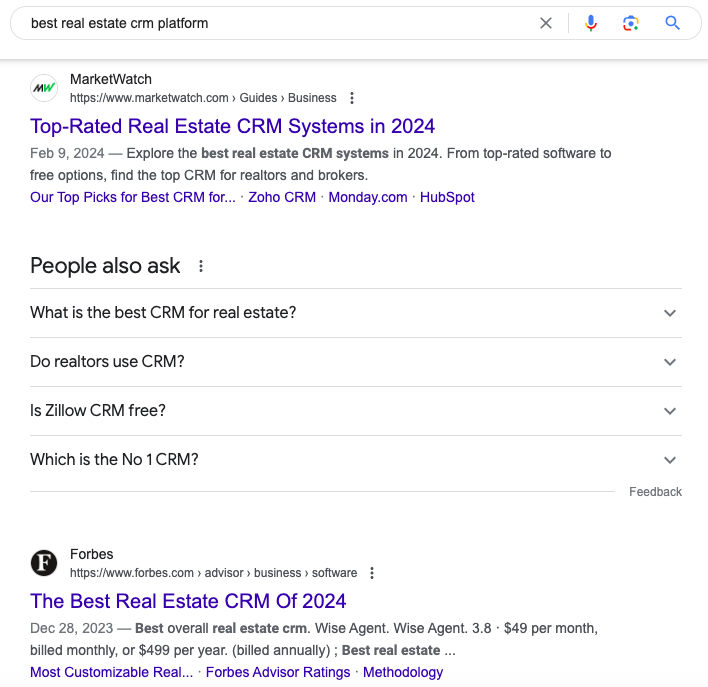
7. Free Tools
Search engines are designed to rank the most helpful content at the top of their results pages, so content writers are incentivized to do anything to make their content the most helpful resource. Therefore, if there’s a helpful tool that could help the reader achieve their goal, the content writer will likely link out to it.
As a result, offering free tools is a great way to earn backlinks. For example, this ROI calculator from HubSpot has over 300 referring domains and over 500 backlinks.
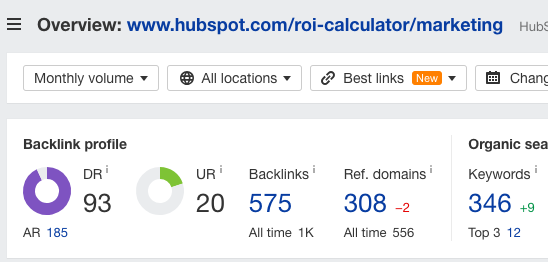
To encourage people to link to your tool, you can also offer an embed link.
However, similar to offering free resources, many SEO professionals now realize that free tools are effective link building tools, so there’s a lot of competition and it can be difficult to make your tool stand out.
Therefore, we aim to only create unique tools that are helpful to our target audience and currently don’t exist elsewhere. A great way to do this is releasing a specific feature from your SaaS product for free.
This strategy works well because it doesn’t cost you anything to develop the future if it already exists in your product, yet it would likely cost other companies a lot of money to duplicate the feature, thereby reducing competition.
For example, Ahrefs offers a number of their features as free tools. It would be difficult and costly for other companies to duplicate many of these tools (like the broken link checker or keyword rank checker), so Ahrefs has much less competition for these helpful tools. As a result, this page has earned nearly 800 referring domains and over 3,000 links:
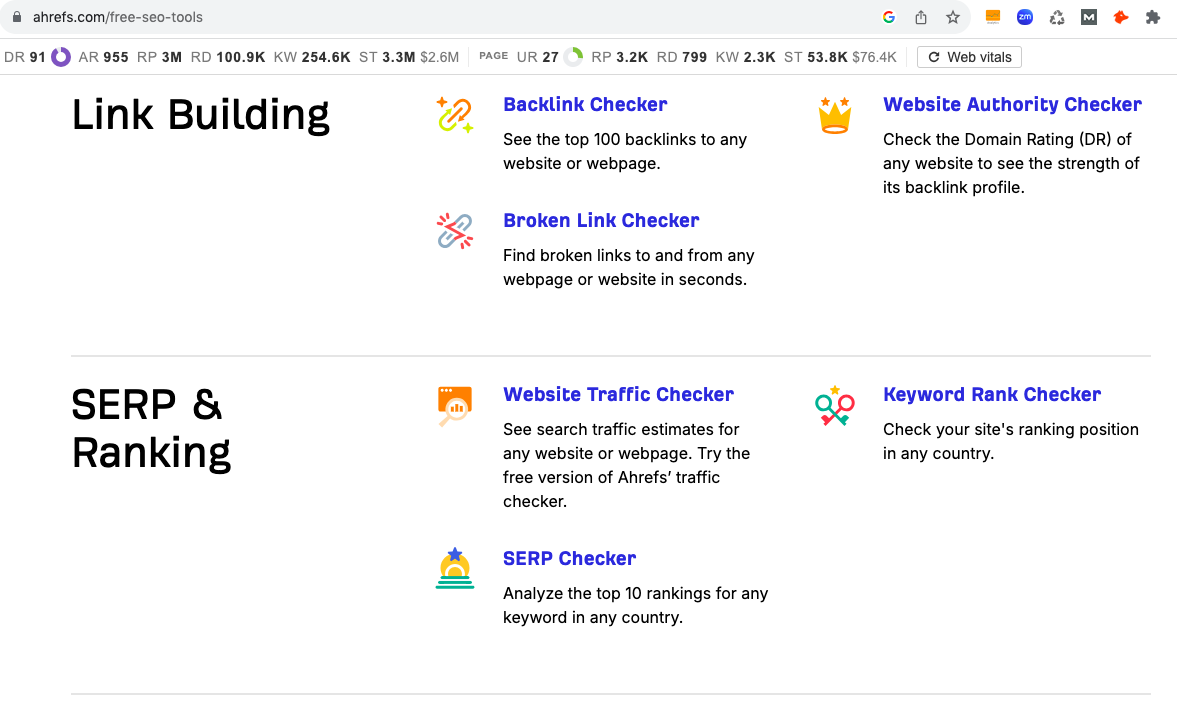
8. Digital PR For Link Building
There are plenty of PR plays that can also help you earn links. Here are a few of our favorite methods to build links through digital PR.
- Press Releases: If you’re releasing a new product, recently hired a new executive, or raised a new round of funding, a press release is a great way to earn links not only from the site that the press release is published on (like TechCrunch or Cision), but also other news websites that need a good story to cover.
- Expert Commentary For SaaS: Journalists and content writers often ask for quotes from experts to add credibility to their content and then they ultimately link back to the source of the quote. Therefore, an easy way to earn links is to offer journalists quotes from executives on your team. You can either use a tool like HARO to find journalists seeking quotes, or you can look at existing roundups and offer to update it for the website to include a quote from one of your executives or other executives. For example, this blog post by Databox is a roundup of expert quotes from 47 experts, so you could offer to update it for them.
- Reactive/Proactive Campaigns: Proactive PR is a strategy to actively connect with journalists and content writers to cover stories about your brand. You can use a tool like HARO to connect with journalists seeking stories. Reactive RP is when you create a campaign in response to an event that took place. This is often referred to as newsjacking and can be a great way to earn links.
9. SaaS Partnerships
There are plenty of other companies that sell products to your ideal customers that aren’t direct competitors, making them excellent link building opportunities.
For example, if you sell webinar software, your customers likely also need email marketing software, course platform software, and various other SaaS tools.
Therefore, you can partner with these other platforms to do joint webinars or cross promote one anothers’ products to earn backlinks.
10. Integration Partners
Your integration partners are also another excellent opportunity to earn backlinks as many of them create partner pages.
For example, Zapier has partner pages for all of its integrations, like this one that promotes its PitchBox integration.
Even if your partners don’t have dedicated integration pages, you can also ask to do a content collaboration with them to earn a backlink. These content collaborations also give your brand more exposure and introduce your brand to a relevant audience.
11. Podcasts
If your executives appear as guests on podcasts, you can earn a link to specific resources they mention on your website as most podcasts include a list of resources in the show notes for each episode.
For example, when entrepreneur Noah Kagan went on the My First Million podcast, they linked to a list of resources Noah mentioned in the show notes:
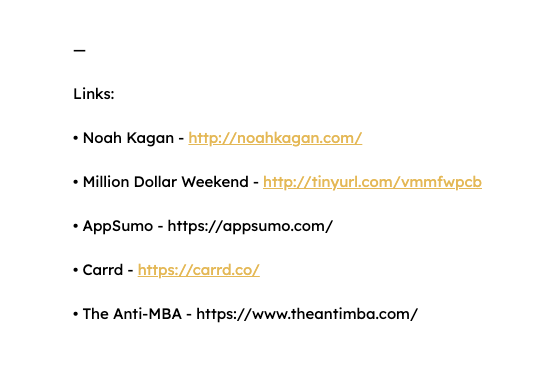
You can use a tool like SparkToro to identify relevant podcasts your audience listens to and then reach out to them by pitching how your executives can add value to them.
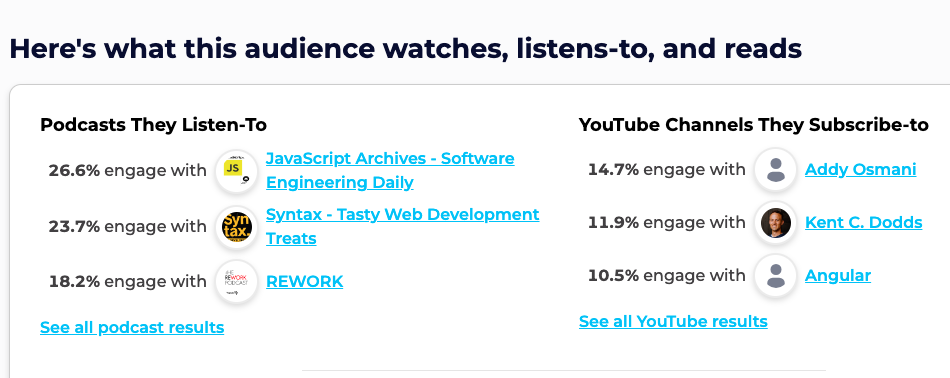
12. Conferences
Another great way to build backlinks and establish your executives as thought leaders is by speaking at conferences. The conference website will likely link back to your website, and they also often have related press releases and other forms of media coverage which can help you earn even more backlinks.
You can also then repurpose the keynote content which can also help attract links to your website.
Even if you can’t land a speaking engagement at a conference, you can still earn a link from the conference and more general brand awareness by sponsoring the event.
13. Widget Link Building
Embeddable widgets or snippets of code that link back to your website are another great way to earn backlinks, but this only works if there is a strong benefit for the user to embed the widget on their website.
The most effective widget link building strategies we’ve seen usually involve some type of badge of credibility or award.
For example, TrustPilot offers a rating widget that users can embed on their site:
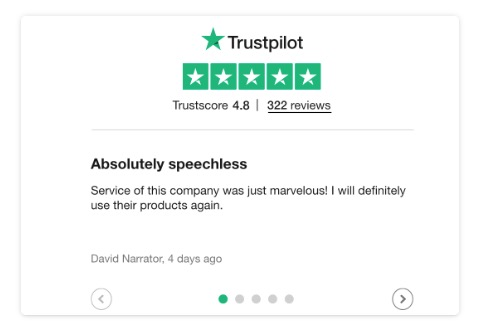
This widget has helped them earn over 234 million backlinks:
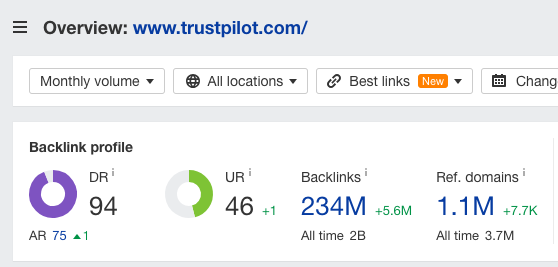
Another option any SaaS company can use is hosting an awards list and giving badges to everyone who makes the list.
14. Reviews And Testimonials
Link building is only effective if there is a strong incentive for the other website to link back to you. One of the best incentives you can provide is reaching out to all of the vendors you use and offering to provide them a review or testimonial if they link back to your website.
This is highly effective because they receive a testimonial, and given that you’re a paying customer, they’re much more likely to oblige to your request.
How To Take Action On These SaaS Link Building Strategies
Link building is challenging because it requires personalized connection with industry experts at scale.
Unfortunately, most SaaS companies only address one of these two components (i.e., spray and pray to pitch as many people as possible or only reach out to a few people with hyper personalized messages).
The key to achieving personalized outreach at scale really comes down to establishing detailed systems and processes.
However, if you want more personalized advice on how to establish a link building strategy that works for your company, reach out to our team today. We’ll provide a free marketing growth plan to help you identify inefficiencies in your current marketing strategy and map out a plan to help you achieve your marketing goals.
We do link building as a part of our Digital PR & Content Promotion services for B2B SaaS companies. Get your Free Marketing Plan to learn more about how we can drive leads for your business through SEO.
What you should do now
Whenever you’re ready…here are 4 ways we can help you grow your B2B software or technology business:
- Claim your Free Marketing Plan. If you’d like to work with us to turn your website into your best demo and trial acquisition platform, claim your FREE Marketing Plan. One of our growth experts will understand your current demand generation situation, and then suggest practical digital marketing strategies to hit your pipeline targets with certainty and predictability.
- If you’d like to learn the exact demand strategies we use for free, go to our blog or visit our resources section, where you can download guides, calculators, and templates we use for our most successful clients.
- If you’d like to work with other experts on our team or learn why we have off the charts team member satisfaction score, then see our Careers page.
- If you know another marketer who’d enjoy reading this page, share it with them via email, Linkedin, Twitter, or Facebook.
